|

|
|
| Ask the Experts | |||||||
|
|||||||
|
March 9, 2009 - Updated March 9, 2009 - Originally Posted Recommended Rework Dwell TimesI need advice on rework dwell time/soldering time. Can a dwell time that lasts too long cause open traces in leaded rework? What is the recommended dwell time in rework process? A. Y. |
|||||||
| Expert Panel Responses | |||||||
|
From the question, the subject seems to be for a hot air rework station where there is temperature control. If you are using a hot air rework station and the reflow process can be observed, we recommend no more than a few seconds of dwell after all the solder has liquefied and stopped moving. This is all the time it takes to be sure the solder has fully wetted out as far as it can. Extra heating time has no advantage. If the process is hidden, up to 30 seconds of dwell may be necessary to ensure all the solder has reflowed and wetted out at the coldest spots in thearea being reworked.
Application Engineering Supervisor Nordson EFD Mr. Vivari has more than 15 years of electronic engineering design and assembly experience. His expertise in fluid dispensing and solder paste technology assists others in identifying the most cost effective method for assembling products.
Dwell time on a reworked component is usually based directly on the dwell time targeted during the production process (your reflow oven). You can refer to the component manufacturer's reflow guidelines and see if any specific notes are given regarding rework. Although lead free solders require hotter rework profiles, the dwell times are still in the 60 to 150 second range for most components. The dwell time ensures that all solder joints have sufficient time above liquidus to create an acceptable solder joint. This joint will have a thin layer of intermetallic compounds. Excessive dwell time will create a thicker layer of IMC, which is more brittle, and will lead to a less reliable joint as the layer grows. I believe open traces could be the result of an improper component removal process, residual solder removal (site preparation) or some other manual process that is not thermally well controlled. Here small layer separation is possible, which can lead to solder wetting to areas away from the pad itself.
Sales Director Finetech Neil O'Brien has worked in the field of electronic manufacturing equipment for over fifteen years and is currently Sales Director for Finetech, a manufacturer of precision rework systems and die bonders.
When hand soldering utilizing Sn/Pb solder, the maximum dwell time at any thru-hole lead should be 20 seconds. A much shorter period of time at each lead is preferred if IPC-A-610D acceptable results are achieved. The solder iron tip temperature should be controlled to a max. temp. of around 300 C. As with any rework process, there is potential for trace damage if time and temperature limits are exceeded.
Product Manager APS-Novastar, LLC Joe Karcewski has been a Process Engineer for 16 years in the industry. He is a certified IPC-A-610 trainer and is presently working at APS-Novastar as a Product Manager for Soldering Systems including Selective Soldering systems.
|
|||||||
| Submit A Comment | |||||||
|
Comments are reviewed prior to posting. You must include your full name to have your comments posted. We will not post your email address. |
|
Free Newsletter Subscription
Circuitnet is built for professionals who bear the responsibility of looking ahead, imagining the future, and preparing for it. Insert Your Email Address |
|

|





